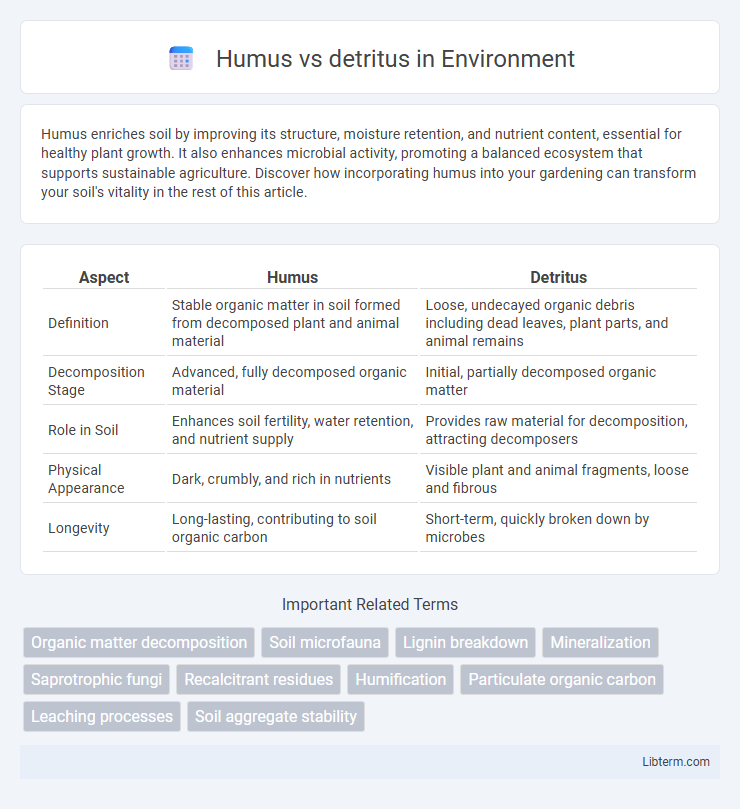Humus enriches soil by improving its structure, moisture retention, and nutrient content, essential for healthy plant growth. It also enhances microbial activity, promoting a balanced ecosystem that supports sustainable agriculture. Discover how incorporating humus into your gardening can transform your soil's vitality in the rest of this article.
Table of Comparison
| Aspect | Humus | Detritus |
|---|---|---|
| Definition | Stable organic matter in soil formed from decomposed plant and animal material | Loose, undecayed organic debris including dead leaves, plant parts, and animal remains |
| Decomposition Stage | Advanced, fully decomposed organic material | Initial, partially decomposed organic matter |
| Role in Soil | Enhances soil fertility, water retention, and nutrient supply | Provides raw material for decomposition, attracting decomposers |
| Physical Appearance | Dark, crumbly, and rich in nutrients | Visible plant and animal fragments, loose and fibrous |
| Longevity | Long-lasting, contributing to soil organic carbon | Short-term, quickly broken down by microbes |
Understanding Humus: Definition and Characteristics
Humus is the dark, organic material in soil formed by the decomposition of plant and animal matter, characterized by its stable, nutrient-rich composition that improves soil fertility and structure. Unlike detritus, which consists of identifiable, partially decomposed organic fragments, humus is fully decomposed, amorphous, and chemically complex, enhancing water retention and microbial activity in the soil. Its presence is essential for nutrient cycling, carbon storage, and sustaining healthy ecosystems in terrestrial environments.
What is Detritus? Key Features Explained
Detritus consists of decomposing organic matter such as dead plants, animals, and microbial residues found in soil and aquatic environments. It plays a crucial role in nutrient cycling by providing a rich source of energy and nutrients for decomposers like bacteria and fungi. Unlike humus, detritus represents the initial, less decomposed stage of organic material before it transforms into stable, nutrient-rich humus.
Formation Processes: Humus versus Detritus
Humus forms through the complex decomposition of organic matter by microorganisms, resulting in a stable, nutrient-rich organic compound that enhances soil fertility. Detritus consists of freshly fallen, undecomposed plant and animal residues that serve as the initial organic material in the decomposition process. Unlike detritus, humus undergoes biochemical changes that stabilize its structure and improve soil water retention and nutrient availability.
Chemical Composition: Humus and Detritus Compared
Humus consists primarily of complex, stable organic compounds such as humic acids, fulvic acids, and humin, which result from the decomposition of plant and microbial residues. Detritus is composed of relatively fresh, undecomposed organic matter including fragments of dead plants, animals, and microorganisms rich in carbohydrates, proteins, and lipids. The chemical composition of humus is more chemically altered and resistant to degradation compared to the labile and nutrient-rich nature of detritus.
Role in Soil Fertility: Humus vs. Detritus
Humus plays a crucial role in soil fertility by improving soil structure, water retention, and nutrient availability through its stable organic matter composition. Detritus consists of recently dead plant and animal material that provides a rapid source of nutrients as it decomposes, feeding soil microorganisms and initiating nutrient cycling. Together, humus and detritus enhance soil fertility by maintaining a balance between long-term nutrient storage and immediate nutrient release.
Importance in Nutrient Cycling
Humus plays a critical role in nutrient cycling by enhancing soil fertility through the slow release of essential nutrients like nitrogen, phosphorus, and potassium, promoting sustained plant growth. Detritus serves as the primary organic matter source decomposed by microorganisms, converting complex organic materials into simpler compounds that enrich the soil. Both humus and detritus facilitate nutrient recycling, maintaining ecosystem productivity and soil health.
Organic Matter Decomposition: Contrasts and Similarities
Humus and detritus represent different stages of organic matter decomposition; detritus consists of freshly fallen plant and animal residues undergoing microbial breakdown, while humus is the stable, complex organic material formed from further decomposition and chemical transformation. Both contribute to soil fertility by recycling nutrients and enhancing soil structure, but humus has a higher carbon-to-nitrogen ratio and greater resistance to microbial degradation compared to detritus. Microbial activity drives the conversion of detritus into humus, linking these processes in the continuum of organic matter decomposition within ecosystems.
Impact on Soil Structure and Texture
Humus significantly improves soil structure by enhancing aggregation, increasing porosity, and promoting water retention, leading to a more friable and nutrient-rich texture. In contrast, detritus, composed of undecomposed organic matter, contributes to soil bulk but has a limited immediate effect on soil aggregation and texture. Over time, the gradual decomposition of detritus into humus plays a crucial role in transforming soil physical properties and fertility.
Ecological Functions of Humus and Detritus
Humus enhances soil fertility by retaining moisture, supplying essential nutrients, and fostering beneficial microbial activity, which supports plant growth and ecosystem productivity. Detritus serves as a critical energy source for decomposers, driving nutrient cycling and organic matter breakdown that sustains soil health. Together, humus and detritus contribute to nutrient retention, soil structure improvement, and ecosystem stability by regulating carbon and nitrogen availability.
Practical Applications in Agriculture and Gardening
Humus improves soil structure, water retention, and nutrient availability, making it essential for enhancing plant growth and crop yields in agriculture. Detritus serves as a raw organic material that decomposes into humus, enriching soil fertility and promoting microbial activity in gardening. Utilizing both humus and detritus supports sustainable soil health management by increasing organic matter content and boosting nutrient cycling.
Humus Infographic

 libterm.com
libterm.com